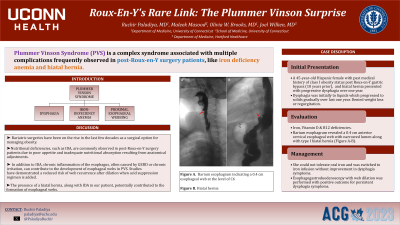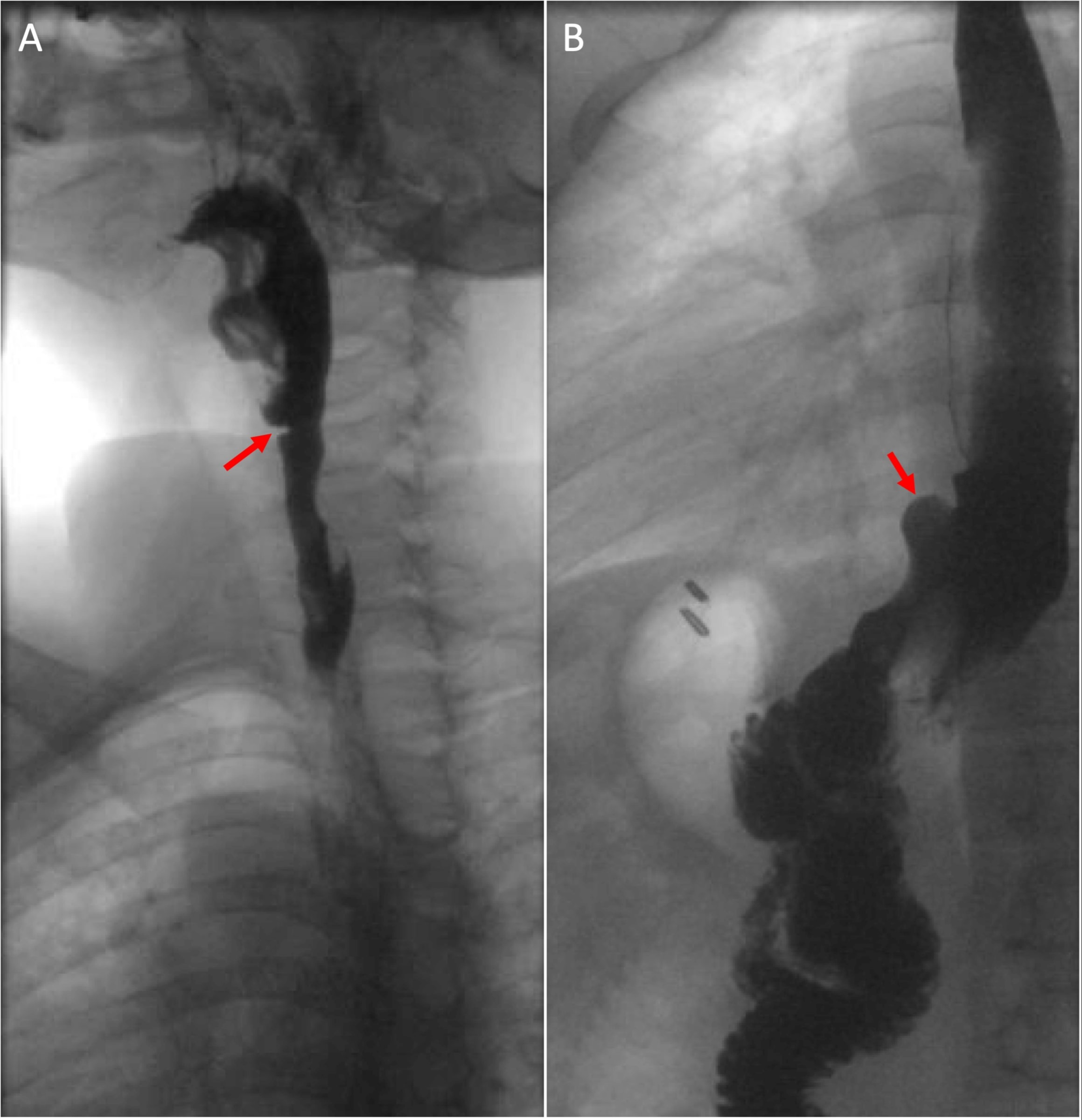Monday Poster Session
Category: Esophagus
P1913 - Plummer-Vinson Syndrome: A Rare Sequela of Roux-En-Y Gastric Bypass Highlighting the Importance of Close Monitoring for Years After Surgery
Monday, October 23, 2023
10:30 AM - 4:15 PM PT
Location: Exhibit Hall

Has Audio

Ruchir Paladiya, MBBS
UConn Health
Hartford, CT
Presenting Author(s)
Award: Presidential Poster Award
Ruchir Paladiya, MBBS1, Maleek Masood, BS2, Olivia W. Brooks, MD2, Joel Wilken, DO3
1UConn Health, Hartford, CT; 2University of Connecticut Health Center, Hartford, CT; 3Hartford Hospital, Hartford, CT
Introduction: Plummer Vinson Syndrome (PVS) is characterized by a triad of dysphagia, proximal esophageal webs, and iron-deficiency anemia (IDA). The reduction in the occurrence of IDA and PVS due to fortification signifies a correlation between chronic deprivation of iron and development of the syndrome. However, not all IDA cases result in esophageal webbing, implying other underlying pathophysiological factors. Herein, we present a case of PVS in a patient with IDA and a hiatal hernia a decade after gastric bypass surgery.
Case Description/Methods: A 45-year-old Hispanic female with past medical history of class I obesity status post Roux-en-Y gastric bypass (10 years prior) and hypothyroidism presented with generalized weakness and progressive dysphagia over one year, initially to liquids and later to solids. The patient denied any significant regurgitation or weight loss over this time. Blood work showed iron deficiency anemia with vitamin D and B12 deficiencies. Barium esophagram revealed a 0.4 cm anterior cervical esophageal web with narrowed lumen along with type I hiatal hernia (Figure A-B). These findings met the qualifications for PVS, and iron supplementation was initiated. Esophagogastroduodenoscopy with web dilation was performed with positive outcome for persistent dysphagia symptoms.
Discussion: Bariatric surgeries have been on the rise in the last few decades as a surgical option for managing obesity. Nutritional deficiencies, such as IDA, are commonly observed in post-Roux-en-Y surgery patients due to poor appetite and inadequate nutritional absorption resulting from anatomical adjustments (i.e., bypassing the duodenum, the primary site of iron absorption). In addition to IDA, chronic inflammation of the esophagus, often caused by GERD or chronic irritation, can contribute to the development of esophageal webs in PVS. Studies have demonstrated a reduced risk of web recurrence after dilation when acid suppression regimen is added. The presence of a hiatal hernia, along with IDA in our patient, could potentially contribute to the formation of esophageal webs. PVS is a complicated syndrome associated with multiple complications frequently observed in post-Roux-en-Y surgery patients, like IDA and hiatal hernia. Esophageal dilation is often necessary in cases of significant obstruction unresponsive to iron supplementation. We hope this case raises awareness for close monitoring of post-surgical complications like hiatal hernia and nutritional deficiencies to prevent sequelae such as PVS.

Disclosures:
Ruchir Paladiya, MBBS1, Maleek Masood, BS2, Olivia W. Brooks, MD2, Joel Wilken, DO3. P1913 - Plummer-Vinson Syndrome: A Rare Sequela of Roux-En-Y Gastric Bypass Highlighting the Importance of Close Monitoring for Years After Surgery, ACG 2023 Annual Scientific Meeting Abstracts. Vancouver, BC, Canada: American College of Gastroenterology.
Ruchir Paladiya, MBBS1, Maleek Masood, BS2, Olivia W. Brooks, MD2, Joel Wilken, DO3
1UConn Health, Hartford, CT; 2University of Connecticut Health Center, Hartford, CT; 3Hartford Hospital, Hartford, CT
Introduction: Plummer Vinson Syndrome (PVS) is characterized by a triad of dysphagia, proximal esophageal webs, and iron-deficiency anemia (IDA). The reduction in the occurrence of IDA and PVS due to fortification signifies a correlation between chronic deprivation of iron and development of the syndrome. However, not all IDA cases result in esophageal webbing, implying other underlying pathophysiological factors. Herein, we present a case of PVS in a patient with IDA and a hiatal hernia a decade after gastric bypass surgery.
Case Description/Methods: A 45-year-old Hispanic female with past medical history of class I obesity status post Roux-en-Y gastric bypass (10 years prior) and hypothyroidism presented with generalized weakness and progressive dysphagia over one year, initially to liquids and later to solids. The patient denied any significant regurgitation or weight loss over this time. Blood work showed iron deficiency anemia with vitamin D and B12 deficiencies. Barium esophagram revealed a 0.4 cm anterior cervical esophageal web with narrowed lumen along with type I hiatal hernia (Figure A-B). These findings met the qualifications for PVS, and iron supplementation was initiated. Esophagogastroduodenoscopy with web dilation was performed with positive outcome for persistent dysphagia symptoms.
Discussion: Bariatric surgeries have been on the rise in the last few decades as a surgical option for managing obesity. Nutritional deficiencies, such as IDA, are commonly observed in post-Roux-en-Y surgery patients due to poor appetite and inadequate nutritional absorption resulting from anatomical adjustments (i.e., bypassing the duodenum, the primary site of iron absorption). In addition to IDA, chronic inflammation of the esophagus, often caused by GERD or chronic irritation, can contribute to the development of esophageal webs in PVS. Studies have demonstrated a reduced risk of web recurrence after dilation when acid suppression regimen is added. The presence of a hiatal hernia, along with IDA in our patient, could potentially contribute to the formation of esophageal webs. PVS is a complicated syndrome associated with multiple complications frequently observed in post-Roux-en-Y surgery patients, like IDA and hiatal hernia. Esophageal dilation is often necessary in cases of significant obstruction unresponsive to iron supplementation. We hope this case raises awareness for close monitoring of post-surgical complications like hiatal hernia and nutritional deficiencies to prevent sequelae such as PVS.

Figure: Figure 1| A. Barium esophagram indicating a 0.4 cm esophageal web at the level of C6; B. Hiatal hernia
Disclosures:
Ruchir Paladiya indicated no relevant financial relationships.
Maleek Masood indicated no relevant financial relationships.
Olivia Brooks indicated no relevant financial relationships.
Joel Wilken indicated no relevant financial relationships.
Ruchir Paladiya, MBBS1, Maleek Masood, BS2, Olivia W. Brooks, MD2, Joel Wilken, DO3. P1913 - Plummer-Vinson Syndrome: A Rare Sequela of Roux-En-Y Gastric Bypass Highlighting the Importance of Close Monitoring for Years After Surgery, ACG 2023 Annual Scientific Meeting Abstracts. Vancouver, BC, Canada: American College of Gastroenterology.

